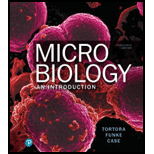
Identify at least one physical and one chemical factor that prevent microbes from entering the body through each of the following:
- a. urinary tract
- b. reproductive tract
To review:
The physical and chemical factors of the urinary tract and reproductive tract which prevent the entry of microbes.
Introduction:
Innate immunity refers to non-specific defense mechanisms, which acts immediately after the exposure of antigens or foreign substances on the body. On the other hand, adaptive immunity refers to antigen-specific immunity that adapts the immune system by the formation of immune cells or memory cells for a specific antigen.
The physical and chemical barriers act as a protective coat or first line of defense for skin and mucus membrane against the environmental pathogens. The physical barrier protects the surface of the body, whereas the chemical factors protect the entry of pathogens through the mucous membrane.
Explanation of Solution
- a. Urinary tract:
Physical factor - It involves the cleaning mechanism of the urethra by the excretion of urine.
Chemical factor - The urinary tract contains the lysozyme enzyme in acidic state, which helps to inhibit the entry of microbes.
- b. Reproductive tract:
Physical factor – It helps to move out the microbes from the female reproductive system.
Chemical factor - In the female reproductive system, the chemical factor is involved in two ways; one is to remove the microbes by creating an acidic environment. The creation of acidic conditions mainly arises due to the breakdown of glycogen in vaginal epithelial cells by lactic acid bacteria. Another one is by cervical mucus, which has antimicrobial ability.
The physical and chemical factors that play a major role in nonspecific defense against foreign substances or microbes is a primary immune response of all vertebrates
Want to see more full solutions like this?
Chapter 16 Solutions
Microbiology: An Introduction Plus Mastering Microbiology with Pearson eText -- Access Card Package (13th Edition) (What's New in Microbiology)
Additional Science Textbook Solutions
General, Organic, and Biological Chemistry - 4th edition
Campbell Essential Biology (7th Edition)
Microbiology Fundamentals: A Clinical Approach
Human Physiology: An Integrated Approach (8th Edition)
Physics for Scientists and Engineers: A Strategic Approach, Vol. 1 (Chs 1-21) (4th Edition)
- How is a protein destined for the Endoplasmic Reticulum (ER), imported into the ER? Be concise.arrow_forwardFind out about the organisations and the movements aimed at the conservation of our natural resources. Eg Chipko movement and Greenpeace. Make a project report on such an organisation.arrow_forwardWhat are biofertilizers and mention the significancearrow_forward
- PCBs and River Otters: Otters in Washington State’s Green-Duwamish River have high levels of polychlorinated biphenyls (PCBs) in their livers. PCBs can bind to the estrogen receptors in animals and disrupt the endocrine system of these otters. The PCBs seem to increase the estrogen to androgen ratio, skewing the ratio toward too much estrogen. How would increased estrogen affect the river otter population? Based on your reading of the materials in this unit, what factors can affect fertility in humans? Explain how each of the factors affecting human fertility that you described can disrupt the human endocrine system to affect reproduction.arrow_forwardOther than oil and alcohol, are there other liquids you could compare to water (that are liquid at room temperature)? How is water unique compared to these other liquids? What follow-up experiment would you like to do, and how would you relate it to your life?arrow_forwardSelection of Traits What adaptations do scavengers have for locating and feeding on prey? What adaptations do predators have for capturing and consuming prey?arrow_forward
- Competition Between Species What natural processes limit populations from growing too large? What are some resources organisms can compete over in their natural habitat?arrow_forwardSpecies Interactions Explain how predators, prey and scavengers interact. Explain whether predators and scavengers are necessary or beneficial for an ecosystem.arrow_forwardmagine that you are conducting research on fruit type and seed dispersal. You submitted a paper to a peer-reviewed journal that addresses the factors that impact fruit type and seed dispersal mechanisms in plants of Central America. The editor of the journal communicates that your paper may be published if you make ‘minor revisions’ to the document. Describe two characteristics that you would expect in seeds that are dispersed by the wind. Contrast this with what you would expect for seeds that are gathered, buried or eaten by animals, and explain why they are different. (Editor’s note: Providing this information in your discussion will help readers to consider the significance of the research).arrow_forward
 Comprehensive Medical Assisting: Administrative a...NursingISBN:9781305964792Author:Wilburta Q. Lindh, Carol D. Tamparo, Barbara M. Dahl, Julie Morris, Cindy CorreaPublisher:Cengage Learning
Comprehensive Medical Assisting: Administrative a...NursingISBN:9781305964792Author:Wilburta Q. Lindh, Carol D. Tamparo, Barbara M. Dahl, Julie Morris, Cindy CorreaPublisher:Cengage Learning Human Physiology: From Cells to Systems (MindTap ...BiologyISBN:9781285866932Author:Lauralee SherwoodPublisher:Cengage Learning
Human Physiology: From Cells to Systems (MindTap ...BiologyISBN:9781285866932Author:Lauralee SherwoodPublisher:Cengage Learning Medical Terminology for Health Professions, Spira...Health & NutritionISBN:9781305634350Author:Ann Ehrlich, Carol L. Schroeder, Laura Ehrlich, Katrina A. SchroederPublisher:Cengage Learning
Medical Terminology for Health Professions, Spira...Health & NutritionISBN:9781305634350Author:Ann Ehrlich, Carol L. Schroeder, Laura Ehrlich, Katrina A. SchroederPublisher:Cengage Learning





